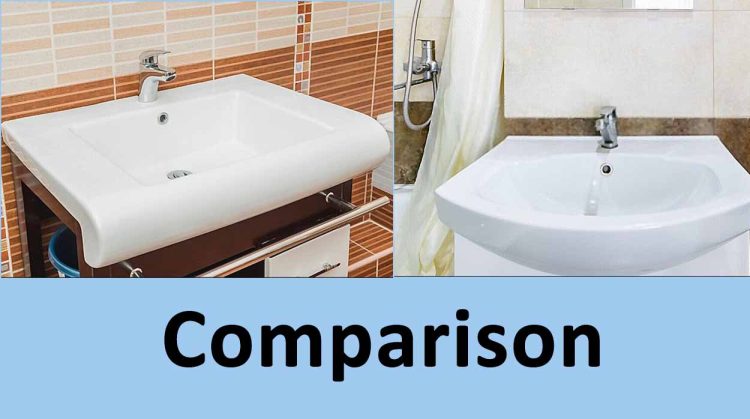When it comes to choosing a new sink for your kitchen or bathroom, you may be wondering whether to go with a ceramic or porcelain sink. Both types of sinks are popular choices due to their durability and attractive appearance, but there are some key differences to consider. Ceramic sinks are made from a type of clay that is fired at a high temperature to create a hard, durable material.
Porcelain sinks, on the other hand, are made from a type of ceramic material that is fired at an even higher temperature, making them even more durable and resistant to chips and cracks. In this article, we will explore the differences between ceramic and porcelain sinks, including their durability, maintenance, and cost, help you make an informed decision.
Porcelain vs Ceramic Sinks – Discussed in Detail
Durability:
When it comes to durability, porcelain sinks tend to be more resistant to chips, cracks, and scratches than ceramic sinks. This is because porcelain is a type of ceramic material that is fired at an even higher temperature than regular ceramic, making it harder and more durable. In addition, porcelain sinks are often glazed, which helps to protect the surface from damage.
Ceramic sinks, on the other hand, are made from a type of clay that is fired at a high temperature to create a hard, durable material. While ceramic sinks are generally quite durable, they may be more prone to chipping and scratching than porcelain sinks.
Both ceramic and porcelain sinks are susceptible to damage if they are subjected to heavy use or abuse, such as dropping heavy objects into the sink or using abrasive cleaners or scrubbers.
To protect your sink and prolong its lifespan, it is important to use a sink mat or cushion to protect the bottom of the sink, and to be careful not to drop heavy objects or place sharp objects in the sink. Regular cleaning and maintenance can also help to keep your sink looking good as new.
Maintenance:
Both ceramic and porcelain sinks are relatively easy to maintain and can be cleaned in a similar way. To clean either type of sink, you can use mild soap and water or a specifically formulated cleaner for the type of material your sink is made of. Avoid using acidic or abrasive cleaners, as these can damage the surface of your sink.
To maintain the appearance of your sink, it is important to clean it regularly and to be careful not to drop heavy objects or place sharp objects in the sink. It is also a good idea to use a sink mat or cushion to protect the bottom of the sink and prevent chips and scratches.
Overall, the maintenance required for ceramic and porcelain sinks is relatively similar. The main difference is the durability of the material – porcelain sinks tend to be more resistant to chips, cracks, and scratches, so they may require less maintenance over time. The procedure to fix a chipped porcelain sink is also very easy as compared to a chipped ceramic sink.
Cost:
The cost of ceramic and porcelain sinks can vary depending on the size, style, and brand of the sink. In general, porcelain sinks tend to be more expensive than ceramic sinks. This is because porcelain is a more durable material and is often glazed, which helps to protect the surface from damage.
Ceramic sinks are generally less expensive than porcelain sinks, but they may not be as durable and may require more maintenance over time.
When shopping for a new sink, it is important to consider the total cost of ownership, including the initial purchase price and any ongoing maintenance or repair costs.
While a more expensive sink may have a higher initial cost, it may be a more cost-effective choice in the long run due to its durability and low maintenance requirements.
Aesthetics:
Both ceramic and porcelain sinks can be aesthetically appealing and can add a touch of style to your kitchen or bathroom. The type of sink that is more aesthetically appealing to you may depend on your personal taste and the overall design of your space.
Ceramic sinks are available in a wide range of colours and styles, including traditional white, earthy tones, and bold shades. They can have a smooth, glossy finish or a more rustic, matte finish, depending on the type of glaze used.
Porcelain sinks are also available in a variety of colours and styles, and they can have a smooth, glossy finish similar to ceramic sinks. In addition, porcelain sinks can be made to mimic the look of other materials, such as stone or marble, which can add a sophisticated touch to your space.
Which one you should buy, a ceramic or porcelain sink?
Well, porcelain sinks are easy to maintain and are made up of high-quality materials. Moreover, it’s very cheap to repair a chipped porcelain sink on your own at home. Ceramic sinks on other hand are prone to chipping and are hard to repair. In the end, it depends upon your needs and what type of sink you prefer in your bath.
Ultimately, the choice between a ceramic or porcelain sink will depend on your personal preference and the overall aesthetic of your space. Both types of sinks can be used to create a stylish and functional kitchen or bathroom.
Pros and Cons of Porcelain Sinks

There are several pros and cons to consider when it comes to porcelain sinks.
Pros:
- Porcelain sinks are very durable and long-lasting. They are resistant to chipping, scratching, and staining, and can withstand high temperatures without being damaged.
- Porcelain sinks are easy to clean and maintain. They can be wiped down with a soft cloth and mild cleaner, and any stains or marks can be easily removed with a little scrubbing.
- Porcelain sinks are available in a wide range of colours and styles, so you can choose one that fits your personal taste and bathroom decor.
- Porcelain sinks are a more environmentally friendly choice than some other materials, such as plastic sinks.
Cons:
- Porcelain sinks can be more expensive than other types of sinks, such as those made of acrylic or stainless steel.
- Porcelain sinks are brittle and can crack if they are subjected to extreme force or impact.
- Porcelain sinks are prone to discolouration over time, especially if they are not cleaned and maintained properly.
- Porcelain sinks can be difficult to repair if they become damaged, as it is hard to match the colour and finish of the sink.
Pros and Cons of Ceramic Sinks

Like porcelain sinks, ceramic sinks have several pros and cons to consider.
Pros:
- Ceramic sinks are durable and long-lasting, with a lifespan that can be measured in decades.
- Ceramic sinks are easy to clean and maintain, as they can be wiped down with a soft cloth and mild cleaner.
- Ceramic sinks are resistant to staining and scratching and are generally less prone to damage than other types of sinks.
- Ceramic sinks are available in a wide range of colours, styles, and shapes, so you can choose one that fits your personal taste and bathroom decor.
Cons:
- Ceramic sinks can be more expensive than other types of sinks, such as those made of acrylic or stainless steel.
- Ceramic sinks are heavy and can be difficult to install, especially if they are large or have an unusual shape.
- Ceramic sinks are brittle and can crack if they are subjected to extreme force or impact.
- Ceramic sinks can be difficult to repair if they become damaged, as it is hard to match the colour and finish of the sink.

Meet Max, the founder and lead writer of our home improvement blog. He is a seasoned home renovation and design expert with over 8 years of experience in the industry.
Max has a passion for creating beautiful and functional living spaces and is dedicated to helping homeowners and DIY enthusiasts achieve their home improvement goals. He has worked on a wide range of projects, from small updates to full-scale renovations, and has a wealth of knowledge and experience to share.
As an avid DIYer, Max understands the challenges and rewards of tackling a home improvement project and enjoys sharing his tips, tricks and insights to make the process as easy and enjoyable as possible. In his free time, Max can be found working on his own home renovation projects, reading design blogs and magazines, and travelling to explore new design trends.
Max is excited to share his knowledge and experience with you and hopes to inspire and empower you to take on your next home improvement project with confidence. Follow Max on LinkedIn for more inspiration and expert advice.


